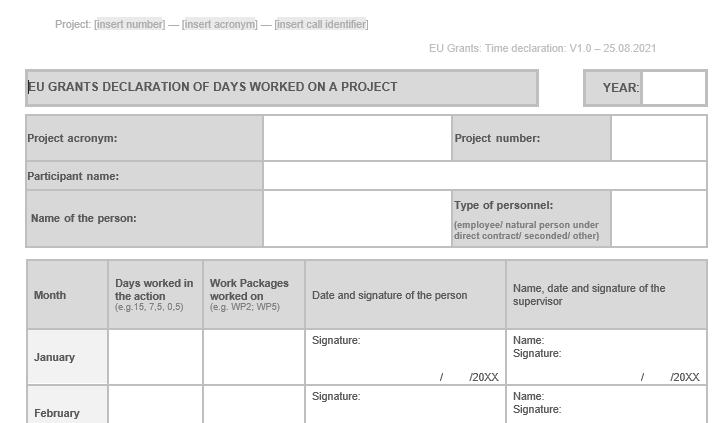Author: Gabriella Lovasz
Timesheets are an essential part of your project implementation process in Horizon Europe. When you claim funds for your project, you must justify the expenditure and staff allocation. This step is crucial to demonstrate that your efforts and resources were properly and realistically allocated to implement the project activities.
Timesheets are vital documentation that the company/organisation must have to demonstrate the time spent by the employees on a specific project.
Filling in timesheets can often be a daunting task for the beneficiaries and their staff, so the European Commission is always trying to simplify this process. Well, in Horizon Europe, there is news on this.
Assigned to the action
You may remember that people need to be assigned to the action for their costs to become eligible. Horizon Europe Annotated Model Grant Agreement states that:
“ONLY costs for personnel assigned to the action (i.e., working for the project according to internal written instructions, organisation chart or other documented management decision) can be eligible. The monthly declaration of days worked in the project correctly signed (see Article 20) or reliable time records will normally be sufficient proof of the assignment to the action — unless there is other contradicting evidence (e.g., the employment contract indicates that the person was hired to work on another project)”.
Time records
For persons who work for the action (regardless of them being full-time or part-time employees and/or if they work exclusively or not for the action; new for 2021-2027), the beneficiary may either:
- use reliable time records (i.e., timesheets) either on paper or in a computer-based time recording system to record (at least) all the hours worked in the action. Reliable time records must be dated and signed at least monthly by the person working for the action and their supervisor. If the time recording system is computer-based, the signatures may be electronic (i.e., linking the electronic identity data, e.g., a password and username, to the electronic validation data), with a documented and secure process for managing user rights and an auditable log of all electronic transactions.
or
- sign a monthly declaration on days spent for the action (template).
It is not clear what should happen if you already have a reliable, hourly-based time recording system used in your organisation (as you needed to have this in H2020). Can you decide to stop using it and turn to the simpler monthly declaration? We are still waiting for the official EC communication on this.
The timesheets should ideally be a daily task in your administration pipeline. They should always be filled in by the person working on the action and approved by their supervisor.
What to include in your new timesheet as minimum information?
- The call identifier, acronym, and number of the action, as specified in the GA
- The beneficiary’s full name, as specified in the GA
- The year
- The full name of the person working for the action
- The number of days worked for the action monthly in the year covered by the time record
- The person’s full name and signature/month
- The supervisor’s full name and signature/month
- A reference to the work packages of Annex 1, to which the person has contributed by the reported working days.

If want to continue using your existing time-recording system where you record your time in hours, you need to convert the productive hours into productive days. Three options are available that are also discussed in the AGA (Page 119 in the November 2021 version).
Very important: The information that you include in the timesheets must match records of the annual leave, sick leave, other leaves, and work-related travel.
Examples of possible alternative evidence for time spent on the project (non-exhaustive list): travel documents proving participation in a project meeting (boarding pass, obliterated travel ticket, hotel invoice, etc.); agenda and minutes of the meeting; attendance lists; working papers; laboratory logbooks; professional/personal diaries; documents related to presentations; scientific publications; correspondence such as letters, notes, memos, emails; etc.
If your organisation is audited in the future, the auditors will use the following three criteria to assess how credible the alternative evidence is:
1. Clear identification of the person concerned
2. Clear link to the project under scrutiny
3. Possibility to quantify time spent on project-related tasks.
Alternative evidence will only be accepted if these three criteria are met.
Good luck with your time recording!
